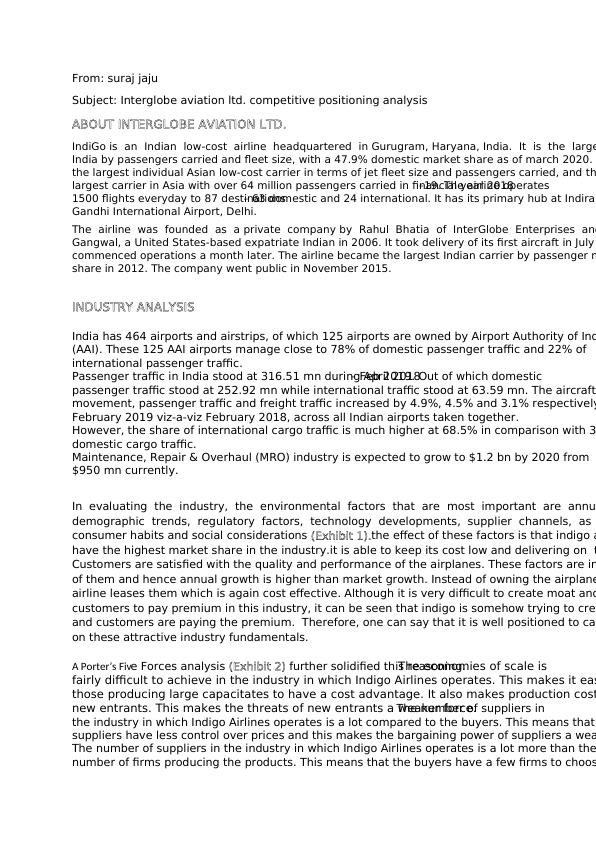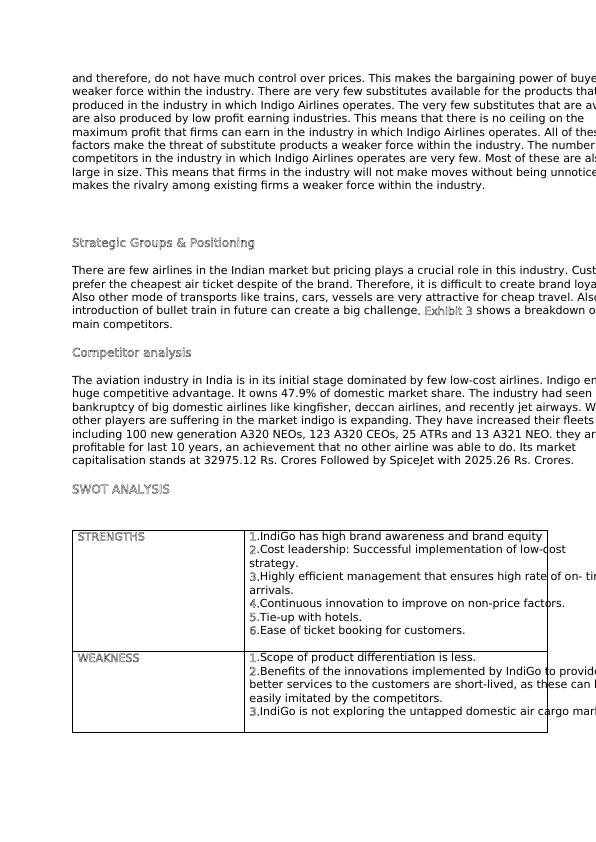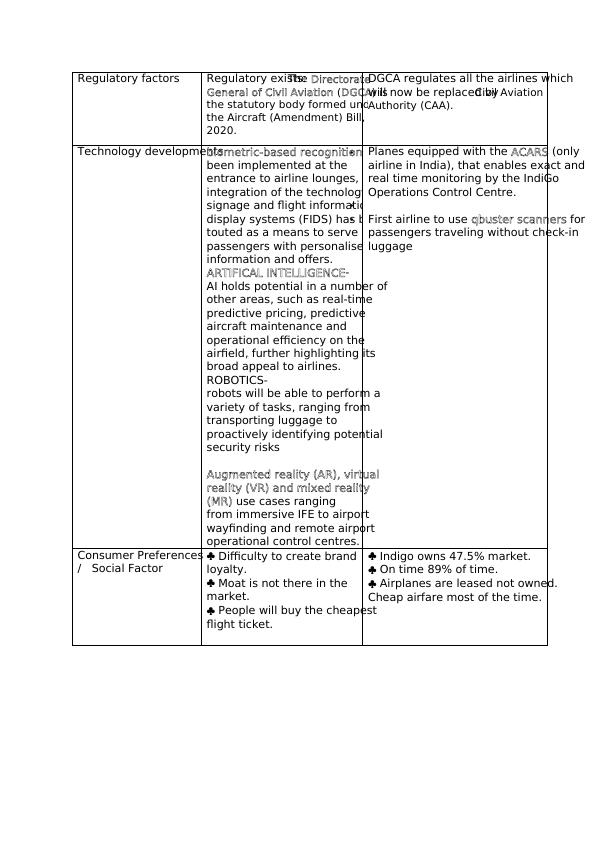Competitive Position: Indigo Airlines
Added on 2021-11-23
12 Pages3764 Words183 Views
From: suraj jaju
Subject: Interglobe aviation ltd. competitive positioning analysis
ABOUT INTERGLOBE AVIATION LTD.
IndiGo is an Indian low-cost airline headquartered in Gurugram, Haryana, India. It is the largest airline in
India by passengers carried and fleet size, with a 47.9% domestic market share as of march 2020. It is also
the largest individual Asian low-cost carrier in terms of jet fleet size and passengers carried, and the sixth
largest carrier in Asia with over 64 million passengers carried in financial year 2018–19. The airline operates
1500 flights everyday to 87 destinations – 63 domestic and 24 international. It has its primary hub at Indira
Gandhi International Airport, Delhi.
The airline was founded as a private company by Rahul Bhatia of InterGlobe Enterprises and Rakesh
Gangwal, a United States-based expatriate Indian in 2006. It took delivery of its first aircraft in July 2006 and
commenced operations a month later. The airline became the largest Indian carrier by passenger market
share in 2012. The company went public in November 2015.
INDUSTRY ANALYSIS
India has 464 airports and airstrips, of which 125 airports are owned by Airport Authority of India
(AAI). These 125 AAI airports manage close to 78% of domestic passenger traffic and 22% of
international passenger traffic.
Passenger traffic in India stood at 316.51 mn during April 2018 – Feb 2019. Out of which domestic
passenger traffic stood at 252.92 mn while international traffic stood at 63.59 mn. The aircraft
movement, passenger traffic and freight traffic increased by 4.9%, 4.5% and 3.1% respectively in
February 2019 viz-a-viz February 2018, across all Indian airports taken together.
However, the share of international cargo traffic is much higher at 68.5% in comparison with 31.5% of
domestic cargo traffic.
Maintenance, Repair & Overhaul (MRO) industry is expected to grow to $1.2 bn by 2020 from
$950 mn currently.
In evaluating the industry, the environmental factors that are most important are annual growth ,
demographic trends, regulatory factors, technology developments, supplier channels, as well as
consumer habits and social considerations (Exhibit 1).the effect of these factors is that indigo airlines
have the highest market share in the industry.it is able to keep its cost low and delivering on time.
Customers are satisfied with the quality and performance of the airplanes. These factors are in favour
of them and hence annual growth is higher than market growth. Instead of owning the airplanes, the
airline leases them which is again cost effective. Although it is very difficult to create moat and allow
customers to pay premium in this industry, it can be seen that indigo is somehow trying to create moat
and customers are paying the premium. Therefore, one can say that it is well positioned to capitalise
on these attractive industry fundamentals.
A Porter’s Five Forces analysis (Exhibit 2) further solidified this reasoning. The economies of scale is
fairly difficult to achieve in the industry in which Indigo Airlines operates. This makes it easier for
those producing large capacitates to have a cost advantage. It also makes production costlier for
new entrants. This makes the threats of new entrants a weaker force. The number of suppliers in
the industry in which Indigo Airlines operates is a lot compared to the buyers. This means that the
suppliers have less control over prices and this makes the bargaining power of suppliers a weak force.
The number of suppliers in the industry in which Indigo Airlines operates is a lot more than the
number of firms producing the products. This means that the buyers have a few firms to choose from,
Subject: Interglobe aviation ltd. competitive positioning analysis
ABOUT INTERGLOBE AVIATION LTD.
IndiGo is an Indian low-cost airline headquartered in Gurugram, Haryana, India. It is the largest airline in
India by passengers carried and fleet size, with a 47.9% domestic market share as of march 2020. It is also
the largest individual Asian low-cost carrier in terms of jet fleet size and passengers carried, and the sixth
largest carrier in Asia with over 64 million passengers carried in financial year 2018–19. The airline operates
1500 flights everyday to 87 destinations – 63 domestic and 24 international. It has its primary hub at Indira
Gandhi International Airport, Delhi.
The airline was founded as a private company by Rahul Bhatia of InterGlobe Enterprises and Rakesh
Gangwal, a United States-based expatriate Indian in 2006. It took delivery of its first aircraft in July 2006 and
commenced operations a month later. The airline became the largest Indian carrier by passenger market
share in 2012. The company went public in November 2015.
INDUSTRY ANALYSIS
India has 464 airports and airstrips, of which 125 airports are owned by Airport Authority of India
(AAI). These 125 AAI airports manage close to 78% of domestic passenger traffic and 22% of
international passenger traffic.
Passenger traffic in India stood at 316.51 mn during April 2018 – Feb 2019. Out of which domestic
passenger traffic stood at 252.92 mn while international traffic stood at 63.59 mn. The aircraft
movement, passenger traffic and freight traffic increased by 4.9%, 4.5% and 3.1% respectively in
February 2019 viz-a-viz February 2018, across all Indian airports taken together.
However, the share of international cargo traffic is much higher at 68.5% in comparison with 31.5% of
domestic cargo traffic.
Maintenance, Repair & Overhaul (MRO) industry is expected to grow to $1.2 bn by 2020 from
$950 mn currently.
In evaluating the industry, the environmental factors that are most important are annual growth ,
demographic trends, regulatory factors, technology developments, supplier channels, as well as
consumer habits and social considerations (Exhibit 1).the effect of these factors is that indigo airlines
have the highest market share in the industry.it is able to keep its cost low and delivering on time.
Customers are satisfied with the quality and performance of the airplanes. These factors are in favour
of them and hence annual growth is higher than market growth. Instead of owning the airplanes, the
airline leases them which is again cost effective. Although it is very difficult to create moat and allow
customers to pay premium in this industry, it can be seen that indigo is somehow trying to create moat
and customers are paying the premium. Therefore, one can say that it is well positioned to capitalise
on these attractive industry fundamentals.
A Porter’s Five Forces analysis (Exhibit 2) further solidified this reasoning. The economies of scale is
fairly difficult to achieve in the industry in which Indigo Airlines operates. This makes it easier for
those producing large capacitates to have a cost advantage. It also makes production costlier for
new entrants. This makes the threats of new entrants a weaker force. The number of suppliers in
the industry in which Indigo Airlines operates is a lot compared to the buyers. This means that the
suppliers have less control over prices and this makes the bargaining power of suppliers a weak force.
The number of suppliers in the industry in which Indigo Airlines operates is a lot more than the
number of firms producing the products. This means that the buyers have a few firms to choose from,

and therefore, do not have much control over prices. This makes the bargaining power of buyers a
weaker force within the industry. There are very few substitutes available for the products that are
produced in the industry in which Indigo Airlines operates. The very few substitutes that are available
are also produced by low profit earning industries. This means that there is no ceiling on the
maximum profit that firms can earn in the industry in which Indigo Airlines operates. All of these
factors make the threat of substitute products a weaker force within the industry. The number of
competitors in the industry in which Indigo Airlines operates are very few. Most of these are also
large in size. This means that firms in the industry will not make moves without being unnoticed. This
makes the rivalry among existing firms a weaker force within the industry.
Strategic Groups & Positioning
There are few airlines in the Indian market but pricing plays a crucial role in this industry. Customers
prefer the cheapest air ticket despite of the brand. Therefore, it is difficult to create brand loyalty.
Also other mode of transports like trains, cars, vessels are very attractive for cheap travel. Also
introduction of bullet train in future can create a big challenge. Exhibit 3 shows a breakdown of the
main competitors.
Competitor analysis
The aviation industry in India is in its initial stage dominated by few low-cost airlines. Indigo enjoys a
huge competitive advantage. It owns 47.9% of domestic market share. The industry had seen
bankruptcy of big domestic airlines like kingfisher, deccan airlines, and recently jet airways. While
other players are suffering in the market indigo is expanding. They have increased their fleets to 261
including 100 new generation A320 NEOs, 123 A320 CEOs, 25 ATRs and 13 A321 NEO. they are
profitable for last 10 years, an achievement that no other airline was able to do. Its market
capitalisation stands at 32975.12 Rs. Crores Followed by SpiceJet with 2025.26 Rs. Crores.
SWOT ANALYSIS
STRENGTHS 1.IndiGo has high brand awareness and brand equity
2.Cost leadership: Successful implementation of low-cost
strategy.
3.Highly efficient management that ensures high rate of on- time
arrivals.
4.Continuous innovation to improve on non-price factors.
5.Tie-up with hotels.
6.Ease of ticket booking for customers.
WEAKNESS 1.Scope of product differentiation is less.
2.Benefits of the innovations implemented by IndiGo to provide
better services to the customers are short-lived, as these can be
easily imitated by the competitors.
3.IndiGo is not exploring the untapped domestic air cargo market.
weaker force within the industry. There are very few substitutes available for the products that are
produced in the industry in which Indigo Airlines operates. The very few substitutes that are available
are also produced by low profit earning industries. This means that there is no ceiling on the
maximum profit that firms can earn in the industry in which Indigo Airlines operates. All of these
factors make the threat of substitute products a weaker force within the industry. The number of
competitors in the industry in which Indigo Airlines operates are very few. Most of these are also
large in size. This means that firms in the industry will not make moves without being unnoticed. This
makes the rivalry among existing firms a weaker force within the industry.
Strategic Groups & Positioning
There are few airlines in the Indian market but pricing plays a crucial role in this industry. Customers
prefer the cheapest air ticket despite of the brand. Therefore, it is difficult to create brand loyalty.
Also other mode of transports like trains, cars, vessels are very attractive for cheap travel. Also
introduction of bullet train in future can create a big challenge. Exhibit 3 shows a breakdown of the
main competitors.
Competitor analysis
The aviation industry in India is in its initial stage dominated by few low-cost airlines. Indigo enjoys a
huge competitive advantage. It owns 47.9% of domestic market share. The industry had seen
bankruptcy of big domestic airlines like kingfisher, deccan airlines, and recently jet airways. While
other players are suffering in the market indigo is expanding. They have increased their fleets to 261
including 100 new generation A320 NEOs, 123 A320 CEOs, 25 ATRs and 13 A321 NEO. they are
profitable for last 10 years, an achievement that no other airline was able to do. Its market
capitalisation stands at 32975.12 Rs. Crores Followed by SpiceJet with 2025.26 Rs. Crores.
SWOT ANALYSIS
STRENGTHS 1.IndiGo has high brand awareness and brand equity
2.Cost leadership: Successful implementation of low-cost
strategy.
3.Highly efficient management that ensures high rate of on- time
arrivals.
4.Continuous innovation to improve on non-price factors.
5.Tie-up with hotels.
6.Ease of ticket booking for customers.
WEAKNESS 1.Scope of product differentiation is less.
2.Benefits of the innovations implemented by IndiGo to provide
better services to the customers are short-lived, as these can be
easily imitated by the competitors.
3.IndiGo is not exploring the untapped domestic air cargo market.

OPPORTUNITY 1. Opening up of International routes can boost business of
Indigo
2. Largest market share among LCCs in Indian Market
3. Middle class taking to the skies can be a huge opportunity
for Indigo airlines Growing demand for foreign travel:
THREATS 1.Plenty of new LCCs to compete with for Indigo airlines
2. Rising Labour costs and changing govt policies
3. Rising Fuel Costs can affect business margins for Indigo
Addendum
Exhibit 1
Environmental analysis
BASIS MARKET INDIGO AIRLINES
Annual growth 18.6% 20.86%
Demographic Trends Rising working group and
widening middle class
demography is expected to boost
demand
India plans to increase the
number of airports to 250 by
2030 to cater to growing leisure
and business travel
Country will become the third
largest aviation market in terms
of passengers by 2026.
Freight traffic also likely to go
up as trade with the rest of the
world increases
Increasing economy and ease of
doing business is allowing more
businesses to grow.
Increase in travel and tourism industry.
Falling crude oil means cheap fuel
for the airline and benefits is passed to
the customers.
Indigo
2. Largest market share among LCCs in Indian Market
3. Middle class taking to the skies can be a huge opportunity
for Indigo airlines Growing demand for foreign travel:
THREATS 1.Plenty of new LCCs to compete with for Indigo airlines
2. Rising Labour costs and changing govt policies
3. Rising Fuel Costs can affect business margins for Indigo
Addendum
Exhibit 1
Environmental analysis
BASIS MARKET INDIGO AIRLINES
Annual growth 18.6% 20.86%
Demographic Trends Rising working group and
widening middle class
demography is expected to boost
demand
India plans to increase the
number of airports to 250 by
2030 to cater to growing leisure
and business travel
Country will become the third
largest aviation market in terms
of passengers by 2026.
Freight traffic also likely to go
up as trade with the rest of the
world increases
Increasing economy and ease of
doing business is allowing more
businesses to grow.
Increase in travel and tourism industry.
Falling crude oil means cheap fuel
for the airline and benefits is passed to
the customers.

Regulatory factors Regulatory exists: The Directorate
General of Civil Aviation (DGCA) is
the statutory body formed under
the Aircraft (Amendment) Bill,
2020.
DGCA regulates all the airlines which
will now be replaced by Civil Aviation
Authority (CAA).
Technology developments biometric-based recognition has
been implemented at the
entrance to airline lounges, and
integration of the technology into
signage and flight information
display systems (FIDS) has been
touted as a means to serve
passengers with personalised
information and offers.
ARTIFICAL INTELLIGENCE-
AI holds potential in a number of
other areas, such as real-time
predictive pricing, predictive
aircraft maintenance and
operational efficiency on the
airfield, further highlighting its
broad appeal to airlines.
ROBOTICS-
robots will be able to perform a
variety of tasks, ranging from
transporting luggage to
proactively identifying potential
security risks
Augmented reality (AR), virtual
reality (VR) and mixed reality
(MR) use cases ranging
from immersive IFE to airport
wayfinding and remote airport
operational control centres.
• Planes equipped with the ACARS (only
airline in India), that enables exact and
real time monitoring by the IndiGo
Operations Control Centre.
•
• First airline to use qbuster scanners for
passengers traveling without check-in
luggage
Consumer Preferences
/ Social Factor
Difficulty to create brand
loyalty.
Moat is not there in the
market.
People will buy the cheapest
flight ticket.
Indigo owns 47.5% market.
On time 89% of time.
Airplanes are leased not owned.
Cheap airfare most of the time.
General of Civil Aviation (DGCA) is
the statutory body formed under
the Aircraft (Amendment) Bill,
2020.
DGCA regulates all the airlines which
will now be replaced by Civil Aviation
Authority (CAA).
Technology developments biometric-based recognition has
been implemented at the
entrance to airline lounges, and
integration of the technology into
signage and flight information
display systems (FIDS) has been
touted as a means to serve
passengers with personalised
information and offers.
ARTIFICAL INTELLIGENCE-
AI holds potential in a number of
other areas, such as real-time
predictive pricing, predictive
aircraft maintenance and
operational efficiency on the
airfield, further highlighting its
broad appeal to airlines.
ROBOTICS-
robots will be able to perform a
variety of tasks, ranging from
transporting luggage to
proactively identifying potential
security risks
Augmented reality (AR), virtual
reality (VR) and mixed reality
(MR) use cases ranging
from immersive IFE to airport
wayfinding and remote airport
operational control centres.
• Planes equipped with the ACARS (only
airline in India), that enables exact and
real time monitoring by the IndiGo
Operations Control Centre.
•
• First airline to use qbuster scanners for
passengers traveling without check-in
luggage
Consumer Preferences
/ Social Factor
Difficulty to create brand
loyalty.
Moat is not there in the
market.
People will buy the cheapest
flight ticket.
Indigo owns 47.5% market.
On time 89% of time.
Airplanes are leased not owned.
Cheap airfare most of the time.

End of preview
Want to access all the pages? Upload your documents or become a member.
Related Documents
Aviation Business and Regulatory Environment in Asialg...
|4
|521
|35
Maintenance, Repair and Overhaul in Aviation Managementlg...
|6
|1219
|82
Aviation Business and Regulatory Environment in ASIAlg...
|1
|470
|87
Feasibility Study for Supply Chain of Low Cost Airline in Australasian Marketlg...
|2
|930
|165
Aviation Investigationlg...
|14
|1067
|92
Marketing Principles and Practices : British Airwayslg...
|19
|4110
|15
